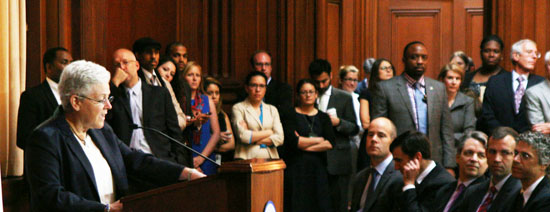
By Matthew Seeman | Cronkite News
Related: Arizona Republicans decry EPA ‘power grab’ over clean water rules
WASHINGTON – Arizona power plants would have to make the second-highest reductions in carbon emissions in the nation under new rules proposed Monday by the Environmental Protection Agency.
The EPA’s Clean Power Plan standard call for a 30 percent reduction in carbon dioxide emissions nationwide by 2030, compared to emission rates in 2005. Arizona power plants would not be called on to hit the lowest levels of pollution, but they would have to make one of the steepest reductions, at just over 50 percent.
When contacted Monday, officials with the Arizona Public Service Corp., the Salt River Project and the Arizona Department of Environmental Quality said they were still reading through the proposal.
“What we’re going to have to do is just look at all the options the EPA lays out and figure out what paths work for Arizona,” said Kara Montalvo, director of environmental compliance and permitting for SRP.
Critics have charged that the new rules, announced Monday by EPA Administrator Gina McCarthy, would make energy more expensive for all and would lead to a loss of jobs in the energy sector. But McCarthy said the nation has a “moral obligation” to act against climate change.
“The science is clear,” McCarthy said. “The risks are clear. And the high costs of climate change keep piling up.”
Besides climate change, McCarthy framed it as a public health issue. She said the new standards would lead to $90 billion in climate and health care savings.
President Barack Obama echoed that in a conference call Monday afternoon, saying the standards would lead to improvements in children’s respiratory health.
“In America, we do not have to choose between the health of our economy and the health of our kids,” Obama said. “We can do both.”
The EPA proposal sets an emissions goal for Arizona power plants of 702 pounds of carbon per megawatt-hour by 2030, a nearly 52 percent reduction from 2012 levels of 1,453 pounds. Only Washington state was given a larger reduction goal, of just under 72 percent.
States would be allowed choose their own methods for reaching reduction goals set by the EPA, such as cap-and-trade programs or increases in renewable energy. The proposal allows a 120-day comment period and aims to have goals finalized within a year. States would then have two to three years to submit their final plans for approval.
Two Arizona generating plants on tribal lands will not be included in the state’s target goal. Navajo Generating Station and the Four Corners Power Plant – identified in recent reports as among the biggest emitters of carbon dioxide in the country – are two of four Native American plants nationwide that “would have the opportunity, but not the obligation, to establish a plan” to cut emissions.
Instead of working through the state, the tribal plants will work directly with the EPA to create or adopt their own programs.
Despite the ambitious goal it set for Arizona, the EPA in its guidelines also singled out the state as having one of the highest energy efficiency resource standards in the
U.S. It cited the Arizona Corporation Commission’s 2010 decision to achieve a 22 percent energy savings from all investor-owned utilities by 2020.
APS played a key role in those goals, the EPA reported, saving 3.2 percent of energy from 2011 to 2012, exceeding the goal of 3 percent and saving consumers more than $200 million in 2012.
McCarthy on Monday downplayed critics’ claims that the new limits could cost jobs, saying similar claims have been raised – and refuted – in the past when the government has set environmental standards, pointing to rules for smog and acid rain, for example.
Far from costing jobs, groups supporting the proposal said the standards would create jobs and save consumers money. A study by the Natural Resources Defense Council claimed the new standards would create 274,000 jobs and save power customers $37.4 billion in 2020.
But a study commissioned by the U.S. Chamber of Commerce – released last week, when it was thought that reduction goals could be as high as 42 percent – found that such a goal could lower the nation’s gross domestic product by an average of $51 billion and lead to 224,000 fewer jobs each year.
Rep. Ann Kirkpatrick, D-Flagstaff, said the proposed guidelines would hurt her district, home to four coal-fired power plants. Coal-burning plants produce more carbon emissions than any other type of plant.
“I will not support efforts that kill jobs in my district and lack provisions for responsibly transitioning us toward a clean-energy economy,” Kirkpatrick said in a statement released Monday.
But others welcomed the change.
Tucson Vice Mayor Paul Cunningham was one of several state and local elected officials who signed a letter to the president last month supporting the tougher emissions standards. Cunningham said the state should focus more on renewable energy and less on coal, which he called an outdated technology.
“Anything that takes us one step closer to solar and Arizona being energy independent is better,” he said.
Clearing the air
Arizona would not have to achieve the nation’s lowest carbon emissions by 2030 under an EPA proposal. but it would have to make one of the steepest cuts from current levels. The goal, in pounds of carbon dioxide per megawatt-hour produced, and the percent reduction from current levels:
• Washington: 71.87 percent (215 lbs/MWh)
• Arizona: 51.69 percent (702 lbs/MWh)
• South Carolina: 51.37 percent (772 lbs/MWh)
• Oregon: 48.05 percent (372 lbs/MWh)
• New Hampshire: 46.30 percent (486 lbs/MWh)
• Arkansas: 44.53 percent (910 lbs/MWh)
• Georgia: 44.41 percent (834 lbs/MWh)
• New York: 44.11 percent (549 lbs/MWh)
• New Jersey: 43.00 percent (531 lbs/MWh)
• Minnesota: 40.62 percent (873 lbs/MWh)











